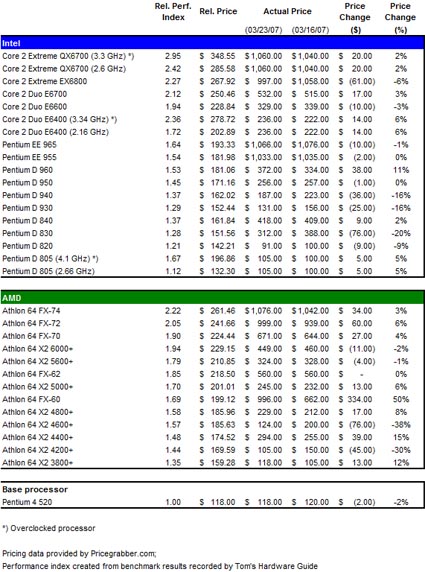AMD dual-core processors scratching $100 mark
Columbus (OH) - This week marks the 25th week since we began looking at processor pricing back in October. We've seen an unprecedented erosion of CPU pricing over this time frame and there's more news this week: AMD's X2 processors have arrived in the entry-level arena of processor prices.
Please visit the article on our TG Daily Beta page for larger and more detailed images
If you have been following our ongoing processor price/performance series, then it is no secret to you that we have been watching AMD very closely. While Intel continues to just have minor blips, AMD continues to shift around its place in the market. A few weeks ago we talked about the fact that AMD's lower-end processors were setting new record low prices. Today that went even further, especially for the 4200+, which fell a whopping 30% from last week.
Over the past couple weeks, processor pricing was more or less stable, especially with the 4200+, which only shifted $9 from March 2 to March 9 and then $11 from March 9 to March 16. This week, however, the average price fell $45 from $150 to $105. This is lowest week-to-week drop we've seen for the 4200+.
This is also crucial, because the 4200+ is a dual-core processor, and the move to the $100 range is a testament of just how competitive AMD is willing to get to rival Intel, if this turns out to be a continuing trend.
Just to clarify, we're looking at the 4200+ with the 90 nm Windsor core and AM2 socket. We are unable to break out whether this the 65 watt or 89 watt version of the processor - both models are in the market and anyone considering AMD X2 processors should be taking the extra effort to find out from the online store which version will be purchased.
Regardless the power consumption rating, the 4200+ exemplifies the pressure on AMD in the current market environment, given the firm's decision to battle for each and everyt point of market share.
Get Tom's Hardware's best news and in-depth reviews, straight to your inbox.
Looking back at a bit of history, AMD announced a huge official price drop in July of last year. On July 24, the firm countered Intel's huge price drops for the Pentium D series for the first time and knocked the 4200+ street price from about $360 to around $200. Even in our inaugural price/performance article on October 6, 2006, the 4200+ still rang in at $192. This average e-tail price drop marks nearly a 50% decline from what was already a massive drop last year, making it about a third of what it was before July 2006.
The 4600+ also saw a massive average price drop this week, going from $200 to $124, a 38% week-to-week decrease, and nearly half of what it was at the beginning of the month. For this processor, we're also looking at the AM2 socket.
Curiously, though, the processor sandwiched in between these two, the 4400+, did not follow this trend. In fact, it jumped in price by $39, marking a 15% week-to-week increase from $255 to $294. It's not quite the $362 we saw for the 4400+ last month, but it's certainly one of the highest we've recorded. Our suggestion would be to stay away from the 4400+ for now.
The bottom line here is that if you want to build or upgrade your computer, go for the 4200+ or 4600+. The 4600+, at an average price of $124, offers about the same performance as an Intel Pentium D 960, which is going for about $372 right now. There is no denying that X2 processors are the way to go these days, especially for mainstream machines that are built with the intention to run Windows Vista.
On that subject, the 5600+ and 6000+ are also looking not to bad. Prices on these two newest processors have been very competitive since they first went on sale about a month ago. The two are now both below their respective tray prices. When looking at corresponding processors, in terms of performance, on the Intel side, the prices are giving Intel a run for its money.
An AMD processor you're obviously going to want to avoid is the FX-60, which carries the notoriously most volatile price in our records. This week is soared 50% from last week, and claimed the highest price we've seen on it over the past 25 weeks, nearing $1000. The FX-60 is part of a dying breed for AMD, so it's on its last legs, and we suspect this dynamic shift is just a result of the bottom falling out from the pool of online retailers.
Also of note are reports that AMD may be announcing official price drops of its 90 nm processors, which could drive related prices down by as much as 30% in the first couple weeks of April.
On the Intel side, there's some good news for entry-level PC makers. The Pentium D 820 hit the lowest price we've seen, crossing the $100 barrier to $91. Expect the $399 class of PCs to integrate dual-core processors from Intel and AMD before the end of Q2 of this year. However, besides this event, there's nothing really that exciting from Intel this week.
We've been watching the QX6700 climb continuously over the past five weeks. On February 16, we saw it at an average of $988, about $12 below the tray price. That was the right time to get into Intel's top-end processor, as the price has gone up non-stop ever since. It's back to $1060 this week, a level it hasn't been at since last year.
In a complete reversal of fortune, the processor right under the QX6700, the EX6800, has been falling every week for the past three weeks, falling 8% ($84) from where it was on March 2. However, we would suggest not to jump on this price just yet. We've seen prices much lower than this on the EX6800 before. Plus, keep in mind that Intel's FSB1333 processors are lining up for launch, which means that this FSB800 generation could get cheaper in the not too distant future.
Every week from December 29 to February 9, we recorded a price lower than $950. Also, kind of surprisingly, our record low on the EX6800 is $921, which was set way back on October 20. Since then, we've noticed a strange cyclical pattern in the processor's price. Fairly constantly, it will climb up to the $1000+ range and then fall to $950 or so. If the past is any indication, the EX6800 could fall even more next week and the weeks thereafter.
Nine of the 15 Intel processors on our list this week had prices that were closer to the record min than the record max, and none of them set a new record max, so there's no processor for Intel that really is a bomb this week. However, there's certainly nothing that's extremely notable. This seems to be the norm for Intel, as it still remains solid in the market.

Mark Raby is a freelance writer for Tom's Hardware, covering a wide range of topics, from video game reviews to detailed analyses of computer processors.
